This is a sponsored post written by Lori Esposito, Chief Marketing Officer, MeetingPlay. More information about Event Manager Blog’s sponsored posts.
![]()
![]()
The best event organizers understand that integrating innovative technology into your planning is the best way to take your event to the next level. In addition to cutting-edge technology like mobile event apps, proximity beacon technology is quickly becoming an effective way to add more value, novelty, and enjoyment of your event.
As an event planner, understanding how to use beacon technology effectively could separate you from other planners and improve your event. After reading this guide, you’ll be better prepared to put beacon technology to work for your business and elevate your events to unexpected levels.
Get ready to astound your attendees, delight your sponsors, and add tremendous value to your event planning business with proximity beacons.
##abovethefold##
What is Proximity Beacon Technology?
Beacon technology exploded onto the scene when Apple released their proximity sensing technology known as iBeacon. Proximity beacons use indoor Bluetooth combined with other mobile technology to pinpoint an app user’s location within a building, like your event venue.
In general, beacon technologies come in two forms, installed and wearable, but work similarly to track your attendees and allow you to incorporate custom features into your event app in either case.
Here’s how the technology works for each:
- Installed Beacons – Installed proximity beacons are Bluetooth-enabled devices that you can place throughout your event venue. These beacons transmit secure IDs that are received by enabled apps on your attendees’ mobile devices. The app then sends the secure ID to the cloud where it can be used to send notifications, alerts, required actions, and updates to your attendee through their mobile event app.
For even more accuracy and functionality, triangular beacons can detect an attendee’s mobile app with multiple beacons. Multiple beacons allow the beacon technology to triangulate the relative position of the mobile device for a more accurate picture of your attendee’s location.
- Wearable Beacons – As their name suggests, wearable beacons are small proximity beacons that you can attach to your attendees’ lanyards. Wearable beacons broadcast Bluetooth LE signals through tiny built-in antennas. Smart devices within range receive the Bluetooth signals and transfer the Beacon ID to the cloud. The cloud can identify the user associated with the Beacon ID and transmit the information back to the smart device and respond with a notification or other action.
![]()
![]()
The main difference between the two is, installed beacons aren’t mobile, so your users need to be near the beacons to use them. Wearable beacons, on the other hand, allow your users to access beacon-driven activities throughout your venue, as long as your attendee is wearing the beacon. As your attendees move, so do their beacon signals.
Installed beacons are like WiFi routers on a desk. You can access them when you’re nearby, but when you’re out of range, you lose the functionality. Using wearable beacons is like having a mobile WiFi hotspot in your pocket. Wherever you go, you get to access the signal and use it to interact with mobile app features.
Both versions of proximity beacons can help you add custom features to your mobile event apps and enhance your attendees’ and vendors’ experiences. But which one should you choose?
Wearable or Installed Proximity Beacons: Which is Better for You?
Every event is different. Depending on your goals, venue, and mobile app features, you may want to choose one form of proximity beacon over the other. Here’s a comparison of the two to help you decide:
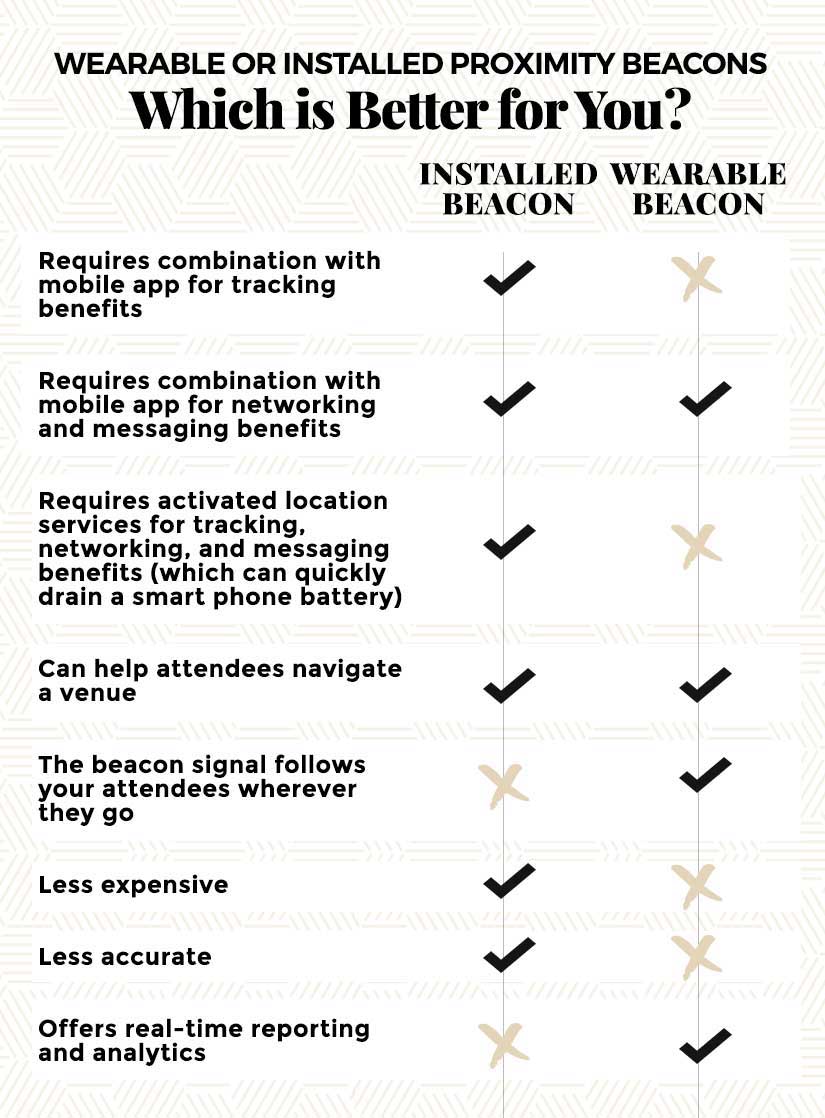

There are times when installed beacons make more sense for your event, like for venue mapping, where installed beacons offer more accuracy and options. However, because of the accuracy and variety of options for mobile event app integration, wearable beacons can transform your event and give you the best value for your investment.
For the remainder of this guide, we’ll focus mainly on the benefits and features associated with wearable proximity beacons due to their flexibility and accuracy. Enough of the tech talk. Let’s dive into all the ways wearable beacons can elevate your event and astound your attendees, vendors, and sponsors.
Using Beacon Technology to Facilitate Event Networking
Many of your attendees have one thing on their minds when they come to your event – networking.


While your attendees understand the importance of networking, it can be difficult for many people to identify who they should meet and find common ground with potential connections.
The uncertainty and frustration many of your attendees feel towards networking create a huge opportunity for event planners to create extraordinary value at their events.
Wearable beacon technology is the perfect tool to help your attendees create meaningful connections and have fun doing it.
Here’s how it works:
Determine Your Networking Criteria
Before your event, you determine the criteria you want to use to create networking recommendations. Popular examples include:
- Tenure and experience
- Job function and title
- Industry or department
- Geographical location
- Hobbies and interests
For even more customization, your attendees can provide additional user information during the registration process or when they set up their profile. Assuming you’re using the right app provider, an algorithm can take the information and develop additional networking criteria and a list of networking connections for each attendee.
Here are a few examples of what this allows you to do: provide mentors to newer employees, facilitate best practice sharing across regions, or introduce new team members following a reorganization.
When your attendees arrive, they receive a lanyard with a wearable beacon attached to it. Their beacon emits a unique signal that contains their user profile information and can be used to interact with the mobile event app. Once you have your app and beacons in place, it’s time to have some fun.
![]()
![]()
Let the Networking Begin
When you combine your mobile event app with wearable beacon technology, you can offer your attendees one-of-a-kind networking experiences. Here’s how proximity beacons can help your app users connect at your event:
- Alerting your attendees when a match is nearby – Proximity beacons know your attendees’ positions in relation to one another. Using that data, you can push notifications through your event app to alert users when they are close to one of their matches.
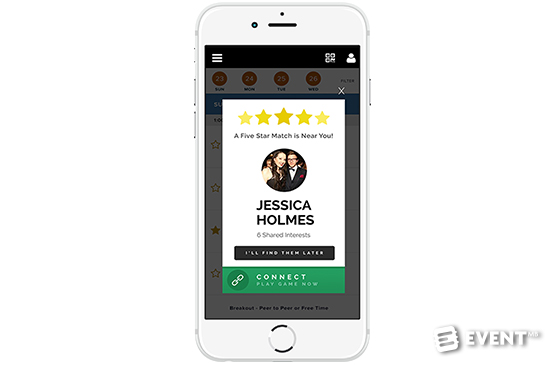

- Displaying user information and profile pictures on your users’ mobile devices – Your attendees don’t have to guess anymore about who to approach, and whether they are speaking to the right person. Pre-loaded profile information makes it easy for your attendees to find one another and make connections easily.
- Providing conversation starters to facilitate easy and meaningful conversation – The days of fumbling for something to talk about are gone. Using proximity beacons and mobile event apps, you can provide your attendees with topics of interest to discuss based on their connection’s profile and pre-app survey.
- Combining wearable beacons with gamification – Depending on your mobile event app provider, you can incorporate gamification features into your mobile event app to further enhance your attendees’ networking experiences. Using their app and proximity beacons, your users can gain points for connecting with other app users. Attendees are encouraged to approach strangers and make new connections, which creates a fun and rewarding environment for networking. Your attendees will be more comfortable connecting with others when you provide them with a relaxed setting that facilitates conversation. Read more about event gamification here.
- Scheduling meetups – When your attendee is alerted that they are near one of their potential connections, they can use their mobile event app to schedule a meetup. Your attendee’s app shows their agenda, as well as their connection’s agenda, and displays time slots where they can schedule a meeting directly in their app. This way, in case the timing isn’t right, your app users can still connect later in the day.
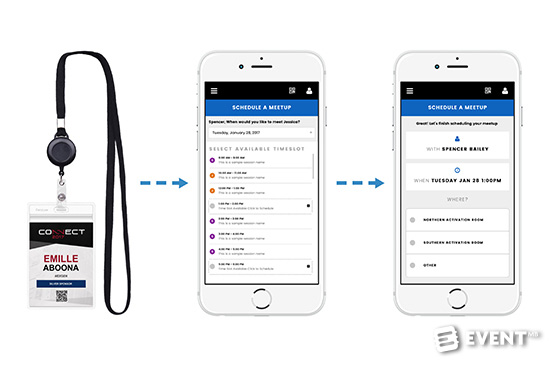

- Displaying Trending Topics – Some mobile event apps allow you to create group discussions in the app around specific topics at your event. As attendees contribute to discussions, your app groups them into trending topics. Using wearable beacon technology, app users can receive alerts when they’re near someone who is contributing to the same discussion group. These alerts can facilitate additional networking opportunities above and beyond an attendee’s predetermined connection list.
Using proximity beacons with your mobile event app makes networking fun for your attendees. No more awkwardness, uncertainty, and frustration. Your attendees will be amazed at how easily they can connect with other app users at your event.
But the transformational uses of wearable beacon technology go beyond networking.
Improve Your Event With Beacon Technology Analytics
What if you could have a bird’s-eye view of your entire event? How much value would it add to your business if you could see what was popular at your event versus what wasn’t working?
Reporting, statistical analysis, and information gathering are valuable parts of your event planning business. And done correctly, they can open your eyes to event trends while also helping you to improve your operations. It’s one of the most impactful ways you can implement technology to benefit your event planning processes.
And believe it or not, wearable beacons can help you with your event reporting, too. Here’s how to supercharge your analytics using wearable technology:
- Create event heat maps – Lanyard beacons let you see where attendees are spending most of their time. This insight can help you identify popular features and vendors, as well as improve the traffic flow of your event while preventing bottlenecks.
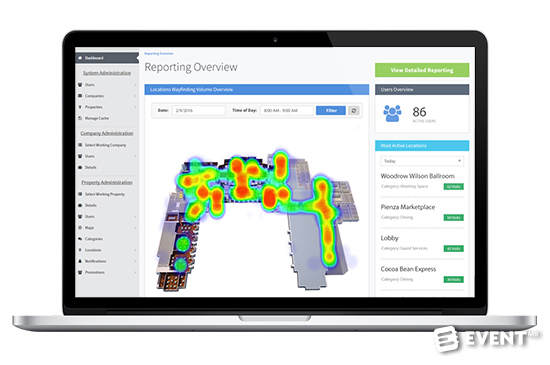

- Obtain real-time data – Wearable beacons transmit information about your event and your attendees in real-time. Using this information, you can modify your event while it’s in progress. Imagine seeing reduced attendance at a lunch event, and being able to adjust your lunch services and labor allocation on the fly. You save time and money with the help of wearable beacon reporting.
- Session Tracking – Wearable beacons give you a virtual view of your attendees’ movements and participation habits. Using real-time feedback, you can see:
- How much time your attendees are spending at event features
- When a large group of people leaves an area prematurely
- Trends related to popular or unpopular content


For example, if you notice that a large group of people leave in the middle of a presentation, it could be the sign of a content issue. You can send out a survey, or have one sent automatically based on your app thresholds, to help you dig into a potential issue. Or maybe, it simply means that you need to schedule a break for your attendees during a long session, and everyone just needs to stretch their legs.
The information you can gather using attendee tracking and wearable beacon technology can alert you to potential event issues, help you improve your content, create a better experience for your attendees, identify opportunities for information gathering, and help you improve your business.
Successful event planners collect data, understand the trends at their events, and adjust their planning based on the conclusions they’re able to draw. Wearable beacons can provide you with reliable data in real-time, and put a spotlight on areas that need additional attention.
Benefits of Using Proximity Beacons for Your Vendors and Sponsors
Securing paying sponsors and vendors is a critical component of your event organization. To attract more sponsors and maximize your revenue, you need to keep your business partners happy while helping them get the most out of the money they invest in your event.
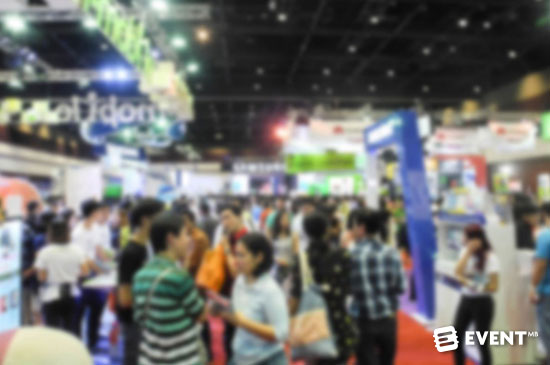

Beacon technology and mobile event apps can add exceptional value to your vendors and sponsors, much as they do for you and your attendees. Here are three ways beacon technology can gratify your vendors and sponsors:
- Increased traffic – Your vendors and sponsors want exposure. They want to interact with as many of your attendees as possible, advertise their products or services, and generate leads that can create additional sales. Beacon technology can help. Leveraging wearable beacon technology and your mobile event app, vendors can send messages to attendees when they are near their booths and encourage them to visit. The same technology that allows you to facilitate networking can also help you increase the amount of traffic and visits to your vendors’ booths.
- Dwell time reporting – The heat mapping and beacon reporting you can use to improve your event can also benefit your vendors and sponsors. Wearable beacons can show vendors which attendees spent significant time at their booth or presentation. If they missed an opportunity to connect with the attendee during the event, your vendors could follow up with them after the event based on the reporting from your wearable beacons. Vendors and sponsors can target their marketing based on strong data identifying potential customers that showed actual interest in their business.
- Traffic evaluations – As discussed previously, wearable proximity beacons can help you analyze foot-traffic patterns at your event. You can use this information to identify areas of your venue that are more exposed than others, and more likely to receive additional traffic. This information is valuable for your business partners. This information can help you to price booths based on real traffic patterns and ensure your vendors are getting the best ROI.
It’s all about ROI – for you, your vendors, and your sponsors. Help your business partners get the most out of your event with increased traffic, greater exposure, and better opportunities to generate valuable leads that can result in sales.
How Beacon Technology Can Benefit Your Venue Provider
If you’re working for a venue or partnering with one, you may be interested in showcasing the features and services of your event location. In addition to the comprehensive networking benefits, wearable beacons, combined with a mobile event app, give you the ability to push user notifications to your attendees. These alerts can be designed to inform your app users about your event venue, and possibly generate revenue for your business.
For example, assume you’re holding your event at a hotel. The hotel features a spa, restaurant, bar and gift shop. Using your app and wearable beacons, you can alert attendees of specials and discounts when they are near a specific service (i.e., half-priced drinks when they walk past the bar). This service provides laser-focused marketing for your venue’s services and helps your attendees stay in the loop on experiences that might interest them.
You can generate revenue for your business by offering this marketing service for a sponsor fee, or provide it free-of-charge as a sign of goodwill. Either way, it benefits your business and helps you create a strong connection with your venue.
Proximity Beacons and Venue Navigation
If your attendees can’t navigate your event’s venue, they can’t appreciate all your hard work and planning. To keep them engaged and happy, you need to help them find the content they’re looking for without the frustration of getting lost.
Once again, combining your mobile event app with beacon technology can provide you with the perfect tool to help eliminate dissatisfaction and confusion from your event. And unlike many of the other proximity beacon features we’ve already discussed, this function works best with installed beacons.
Installed beacons throughout your event can communicate with your attendees’ mobile event apps and allow them to use location services on their mobile device to access interactive maps of your event venue that mimic mapping software they use every day.
Help your attendees get the most out of their event experience by combining beacon technology with your mobile event app to give your attendees the convenience of GPS-like tracking inside your venue.
In Conclusion
While you carry a variety of tools in your event-planning toolbelt, beacon technology may be the most valuable resource you have at your disposal. Let’s recap all the amazing benefits beacon technology and mobile event apps provide:
- Increased attendance and engagement – The enhanced networking capabilities of beacon technology can draw attendees and keep them engaged during your event.
- Improved business processes – Data is critical to the success of your business. Beacon technology can help you get real-time data to improve your event planning before, during and after your event.
- Better return on investment – Beacon technology can help you maximize your return on investment by monetizing your event app and attracting paying vendors and sponsors. You can even use beacon technology to offer paid sponsorships to your venue.
- Negative review prevention – Proximity beacon technology helps you get out in front of negative reviews and stop them before they happen.
While beacon technology can enhance your attendees’ experiences, the greatest benefit may be the value it adds to you and your stakeholders.
Put technology to work for you. Make your life easier, improve your business, and astound your attendees by combining proximity beacons with your mobile event app.





